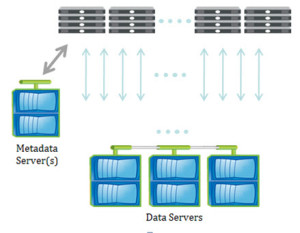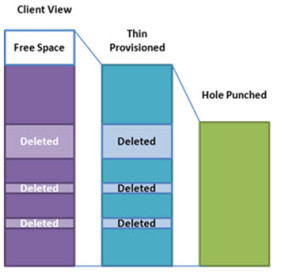Cloud File Services: SMB/CIFS and NFS…in the Cloud – Q&A
At our recent live ESF Webcast, “Cloud File Services: SMB/CIFS and NFS…in the Cloud” we talked about evaporating your existing file server into the cloud. Over 300 people have viewed the Webcast. If you missed it, it’s now available on-demand. It was an interactive session with a lot of great questions from attendees. We did not have time to address them all – so here is a complete Q&A from the Webcast. If you think of additional questions, please feel free to comment on this blog.
Q. Can your Storage OS take advantage of born-in-the-cloud File Storage like Zadara Storage at AWS and Azure?
A. The concept presented is generic in nature. Whichever storage OS the customer chooses to use in the cloud will have its own requirements on the underlying storage beneath it. Most Storage OS’s used for Cloud File Services will likely use block or object backends rather than a file backend.
Q. Regarding Cloud File Services for “Client file services,” since the traditional file services require the client and server to be in a connected mode, and in the same network. And, they are tied to identities available in the network. How can the SMB/NFS protocols be used to serve data from the cloud to the clients that could be coming from different networks (4G/Corporate)? Isn’t REST the appropriate interface for that model?
A. The answer depends on the use case. There are numerous examples of SMB over the WAN, for example, so it’s not far fetched to imagine someone using Cloud File Services as an alternative to a “Sync & Share” solution for client file services. REST (or similar) may be appropriate for some, while file-based protocols will work better for others. Cloud File Services provides the capability to extend into this environment where it couldn’t before.
Q. Is Manila like VMware VSAN or VASA?
A. Please take a look at the Manila project on OpenStack’s website https://wiki.openstack.org/wiki/Manila
Q. How do you take care of data security while moving data from on-premises to cloud (Storage OS)?
A. The answer depends on the Storage OS you are using for your Cloud File Services platform. If your Storage OS supports encryption, for example, in its storage-to-storage in-flight data transport, then data security in-flight would be taken care of. There are many facets to security that need to be thought through, including security at rest, some of which may depend on the environment (private/on-premises, service provider, hyperscalar) the Storage OS is sitting in.
Q. How do you get the data out of the cloud? I think that’s been a traditional concern with cloud storage.
A. That’s the beauty of Cloud File Services! With data movement and migration provided at the storage-level by the same Storage OS across all locations, you can simply move the data between on-premises and off-premises and expect similar behavior on both ends. If you choose to put data into a native environment specific to a hyperscalar or service provider, you run the risk of lock-in.
Q. 1. How does one address issue of “chatty” applications over the cloud? 2. File services have “poor” performance for small files. How does one address that issue? Block & Objects do address that issue 3. Why not expose SMB, NFS, Object Interface on the Compute note?
A. 1. We should take this opportunity to make the applications less chatty! 🙂 One possible solution here is to operate the application and Storage OS in the same environment, in much the same way you would have on-premises. If you choose a hyperscalar or service provider, for chatty use cases, it may be best to keep the application and storage pieces “closer” together.
2. Newer file protocols are getting much better at this. SMB 3.02 for instance, was optimized for 8K transactions. With a modern Storage OS, you will be able to take advantage of new developments.
3. That is precisely the idea: the Storage OS operating in the “compute nodes,” serving out their interfaces, while taking advantage of different backend offerings for cost and scalability.
Q. Most storage arrays NetApp, EMC etc., can provide 5 9s of resilience, Cloud VMs typically offer 3 9’s. How do you get to 5 9’s with CFS?
A. Cloud File Services (CFS) as a platform can span across all of your environments, and as such, the availability guarantees will depend upon each environment in which CFS is operating.
Q. Why are we “adding” another layer? Why can we just use powerful “NAS” devices that can have different media like NVMe, Flash SSD or HDDs?
A. Traditional applications may not want to change, but this architecture should suit those well. It’s worth examining that “cloud-ready” model. Is the goal to be “cloud-ready,” or is the goal to support the scaling, failover, and on-demand-ness that the cloud has the ability to provide? Shared nothing is a popular way of accomplishing some of this, but it may not be the only way.
The existing interfaces provided by hyperscalars do provide abstraction, but if you are building an application, you run a strong risk of lock-in on any particular abstraction. What is your exit strategy then? How do you move your data (and applications) out?
By leveraging a common Storage OS across your entire infrastructure (on-premises, service providers, and hyperscalars), you have a very simple exit strategy, and your exit and mobility strategy become very similar, if not the same, with the ability to scale or move across any environment you choose.
Q. How do you virtualize storage OS? What happens to native storage OS hardware/storage?
A. A Storage OS can be virtualized similar to a PC or traditional server OS. Some pieces may have to be switched or removed, but it is still an operating system.
Q. Why is your Storage displayed as part of your Compute layer?
A. In the hyperscalar model, the Storage OS is sitting in the compute layer because it is, in effect, running as a virtual machine the same as any other. It can then take advantage of different tiers of storage offered to it.
Q. My concern is that it would be slower as a VM than a storage controller. There’s really no guarantee of storage performance in the cloud in fact most hyperscalers won’t give me a good SLA without boatloads of money. How might you respond to this?
A. Of course with on-premises infrastructure, a company or service provider will have more of a guarantee in the sense that they control the hardware behind it. However, as we’ve seen, SLA’s continue to improve over time, and costs continue to come down for the Public Cloud.
Q. Does FreeNAS qualify as a Storage OS?
A. I recommend checking with their team.
Q. Isn’t this similar to Hybrid cloud?
A. Cloud File Services (CFS) is one way of looking at Hybrid Cloud. Savvy readers and listeners will pick up that having the same Storage OS everywhere doesn’t necessarily limit you to only File Services. iSCSI or RESTful interfaces could work exactly the same.
Q. What do you mean by Storage OS? Can you give some examples?
A. As I work for NetApp, one example is Data ONTAP. EMC has several as well, such as one for the VNX platform. Most major storage vendors will have their own OS.
Q. I think one of the key questions is the data access latency over WAN, how I can move my data to the cloud, how I can move back when needed – for example, when the service is terminated?
A. Latency is a common concern, and connectivity is always important. Moving your data into and out of the cloud is the beauty of the Cloud File Services platform, as I mentioned in other answers. If one of your environments goes down (for example, your on-premises datacenter) then you would feasibly be able to shift your workloads over to one of your other environments, similar to a DR situation. That is one example of where storage replication and application awareness across sites is important.
Q. Running applications like Oracle, Exchange through SMB/NFS (NAS), don’t you think it will be slow compared to FC (block storage)?
A. Oracle has had great success running over NFS, and it is extremely popular. While Exchange doesn’t currently support running directly over SMB at this time, it’s not ludicrous to think that it may happen at some point in the future, in the same way that SQL has.
Q. What about REST and S3 API or are they just for object storage? What about CINDER?
A. The focus of this presentation was only File Services, but as I mentioned in another answer, if your Storage OS supports these services (like REST or S3), it’s feasible to imagine that you could span them in the same way that we discussed CFS.
Q. Why SAN based application moving to NAS?
A. This was discussed in one of the early slides in the presentation (slide 10, I believe). Data mobility and granular management were discussed, as it’s easier to move, delete, and otherwise manage files than LUNs, an admin can operate at a more granular level, and it’s easier to operate and maintain. No HBA’s, etc. File protocols are generally considered “easier” to use.

